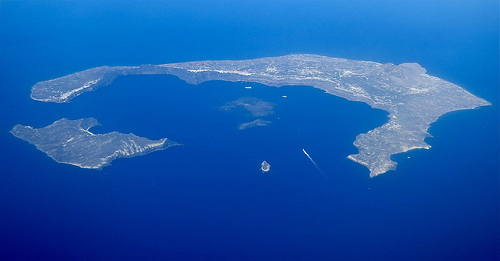Santorini is an archipelago shrouded with mystery.
- Santorini is an archipelago of five islands that is part of Greece, and is located in the Aegean Sea, in the Mediterranean Sea.
- ‘Santorini’ is also known as ‘Thera’ and ‘Thira’, while the main island is known by the same name – it was named during the Latin empire after the cathedral Saint Irene, and was originally known in the Greek empire as ‘Kallístē’, ‘Strongýlē’ and ‘Thēra’, although the latter was eventually reinstated officially.
- Santorini has a total area of 90.6 square kilometres (35 square miles), with the main island measuring 73 square kilometres (28 square miles), and it has a bus service, a major airline service and two ports for watercraft.
- The Santorini archipelago was originally a single island which was destroyed, most likely between 1500 BC to 1700 BC, by the devastating Minoan or Thera volcanic eruption, and before its destruction the original island was well populated, and it was rediscovered and resettled after the Bronze Age.
- In 2011, Santorini was the home to approximately 15 thousand people, all inhabiting the main island, except for a small population of approximately 150 that live on the island of Therasia.
Santorini Archipalego
Image courtesy of Steve Jurveston/Flickr
- The Santorini islands surround the dormant volcano that destroyed the original island, which is, out of the surrounding volcanic chain known as the South Aegean Volcanic Arc, currently the most volcanically active, and its last eruption was in 1950, and activity was recorded from 2011-2012.
- Santorini has been ruled by a number of different empires throughout its history, including the Minoan, Greek, Roman, Latin and Ottoman Turkish empires, and most recently, in 1830, it was reclaimed by Greece.
- Even though up until the 1990s the availability of fresh water was scarce, people on the main island of Santorini have been able to establish prominent wine and tomato agricultural industries.
- It is said that one of the locations on the original single Santorini Island, now dubbed as ‘Akrotiri’, is possibly the lost city of Atlantis, a Greek-originating legend, that was described by Plato.
- Santorini buildings are typically Greek in their architectural style, and are shaped as strikingly white cubes, although many of the buildings were destroyed by an earthquake in 1956.
Bibliography:
Geography, 2014, Santorini, http://www.santorini.net/about-santorini/geography/
Santorini, 2014, Wikipedia, http://en.wikipedia.org/wiki/Santorini









for travellers to santorini here is a weather guide that will help you plan the perfect vacation there.
https://www.visitgreece.com.gr/en/members/travel-blog/item/622-santorini-weather-guide.html
Why has not more marine archeological research of the bottom of the ancient caldera I believe that all the evidence needed to put an end to the mystery of the fabled land of Atlantis lies at the bottom of that caldera.